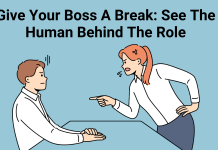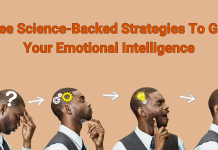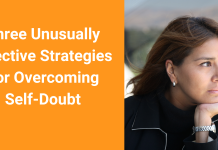
Imagine if you could discover how the world truly sees you.
In order to play to your strengths it’s imperative to know how people see you when you’re at your very best. By embracing the unique qualities that make you fascinating instead of trying to fix your perceived weaknesses, you can become a source of energizing authenticity. So how do you discover your individual strengths? And how do they help you captivate?
Sally Hogshead is an award-winning branding expert, a hall of fame speaker, and the world's authority on the science of fascination. Her company developed the first methodology to measure your personal brand called ‘Your Fascination Advantage’. Her best-selling books include How the World Sees You and Fascinate: How to Make Your Brand Impossible to Resist. I recently interview Sally for the LEADx podcast, where we discussed the key to becoming truly fascinating. (The interview below has been lightly edited for space and clarity.)
Kevin Kruse: I recently took the Fascination Advantage Assessment and got ‘Veiled Strength’ as my archetype. What does that mean?
Sally Hogshead: When you took the Fascination Advantage Assessment, you learned that there are two different ways that you are most likely to be seen at your best, and the first way is you're a great listener. That's called the ‘Mystique Advantage’. The second way is that you have power–meaning, you lead with confidence. So, the archetype that you have or how your personal brand is seen at its best is the ‘Veiled Strength.’ And here's what that means. I want you to think of a world championship poker player who's sitting at the table, who's not gonna give away all the clues, who's gonna listen and watch and see the tells of the people around them. You know what I mean when I say a ‘tell,’ right?
So, watching those ‘tells’ and then playing very strategically to think two steps ahead, that's what we learned when you took the Fascination Advantage Assessment. The three adjectives that describe you are realistic, intentional, and to-the-point. When you think about who you are at your best, in other words, when people are most impressed by how you're adding value, which one of those three best describes it? Realistic, intentional, or to-the-point?
Kruse: I'm gonna go with to-the-point.
Hogshead: Let's describe this for a moment. Imagine that you're going into one of those situations when you want to play your A game. What would be a situation like that, Kevin?
Kruse: I have a high-stakes meeting with an editor soon, and I'd like to change the proposal for a book, how might I approach that with strength?
Hogshead: Now, remember, when you took the assessment, your result was the ‘Veiled Strength.’ And what we just identified is the way in which you are most likely to add value in that meeting, to be seen at the top of your game is to-the-point. That's the descriptive phrase. That's how you're different.
So, Kevin, when you go into this meeting, here's how I want you to think about this. The doors are about to open, or you're going up in the elevator and when you walk in you don't have to create a lot of drama, you don't have to add a lot of fluff. You want to sit down and say, “I have an idea that I want so share with you. It's a pivot from where we were before. Before, what we were looking at was giving three bullet points and then proposing what we do. And then you list the three bullet points and show it as a trajectory. In other words, you're building upon what you already did before.
I would have a very different approach. When I take the Fascination Advantage, which, although I created it, I have done. I fascinate very differently than you. In other words, I add value differently and whereas you are the ‘Veiled Strength’, so you don't communicate with a lot of emotion. You are not chaotic. You're not unorthodox in the way that you communicate. My archetype is the ‘Catalyst’. The three ways the ‘Catalyst’ is most likely to differentiate themselves is by being out of the box, social, and energizing. These are the three adjectives that describe my personal brand.
If I were to go into that meeting, let's say I'm going up on the elevator and the elevator dings and the doors open and I walk into the meeting, the way I would be most likely to add value to the meeting is by saying, “I am so excited to see you today and I love the original book concept that we did but I've been thinking about it and I think I've evolved it. We could do something slightly different that I think would be even more effective. Let me tell you a story about it.” And then I would give them adjectives and descriptors. I would make them feel something. So the way I'm most likely to add value is by having my listener experience an emotion. You, on the other hand would be ‘to the point’.
Kruse: So your best shot is to be yourself and lead with your strengths. Is that how I should approach this?
Hogshead: Yes. And let me give you a specific example. We've measured a million professionals inside of Twitter and Porsche and GE and AT&T. It's growing exponentially. And I did a study of the high performers. What do the people at the top of their game do differently? And there were two things they did differently in their performance.
The first thing they did was they delivered a specific benefit. So, they weren't trying to be all things to all people. They were not trying to be pretty good in a lot of areas. They essentially identified: here's how I'm most likely to add value, here’s how I can distinguish myself, and then they totally honed in and doubled down on that benefit. They are people who are good at details, and were really good at details. They made a point to attract assignments, clients, customers, co-workers who needed detail orientation. They delivered the spreadsheets. They gave the in-depth analytics. They did not worry about being the cheerleader, the visionary, the brainstormer, because for them that was almost like a disadvantage.
The second thing that high performers do differently is they have a specialty, and they're associated with this specialty so people come to them. Their ideal client seeks them out and comes to them for this specialty. If I were to go into a meeting, say that A game meeting that we just described, if I went in and tried to be realistic, intentional, and to-the-point like you, not only would it be stifling but I would be inauthentic. I wouldn't be adding value in the way my personal brand is primed.
You on the other hand, if we said, “Hey, Kevin, you're energetic but go into this meeting and we want you to be out of the box and social,” That would feel hyper for you. And let's be honest. It would kind of be exhausting for you, wouldn't it?
So say I'm a client working with you and I said, “Kevin, I want you to write me an article and it's gonna be flowery and I want you to be super effusive in this writing.” That would probably feel like an assignment that is setting you up for failure, wouldn't you think?
But if I said, “Listen, Kevin, a high profile magazine like Forbes wants you to just give killer content, hone it down, give us bullet points.” You're the man, because we just described the way in which you're most likely to differentiate is by being to the point.
And so here's the thing: People add value in specific ways. The problem is that within workplace culture, too often we're focused on trying to fix ourselves. We focus on our weaknesses. I don't believe in strengths versus weaknesses. In my studies, I'm not measuring, “How do you see the world?” I'm measuring, “How does the world see you?” In other words, like Myers-Briggs or DISC or StrengthsFinder, which are all gold standard assessments, those are built on psychology, so those are measuring how do you see the world. Instead, I built my assessment on branding and I created the algorithm exactly the way I did with world-class brands in focus groups. Think about it, MINI Cooper, one of my former clients. MINI Cooper doesn't care about how MINI sees the world. MINI only cares about how does the world see MINI? How does the consumer see MINI?
So, for anybody, if you understand how other people see you at your best, it becomes so much easier. Frankly it's a relief to think, okay, Kevin, you don't need to be out of the box, social, and energizing. And it's a relief for me to know I don't have to be realistic, intentional, and to the point. It's not that we can't, it's just not gonna be our wellspring.
Kruse: Can you highlight them? Like what the ‘seven triggers’ are?
Hogshead: Sure. I started as a creative director which is coming up with the big concept ideas for television commercials for brands like Nike, Target, and Coca-Cola. What I found was there's a shortcut to coming up with a brand. If you can identify which one of these seven categories a brand message falls into, it becomes a lot easier for you to create the marketing message.
The seven different advantages include ‘Innovation,’ which is a brand that communicates with creativity; ‘Passion,’ which is a brand that communicates with emotion; ‘Power,’ ‘Prestige,’ and ‘Trust,’ ‘Mystique’ and ‘Alert’. Once you can categorize where your brand message should be, then you can kind of specialize exactly like the high performers I was talking about.
In 2010, I began studying how people fascinate. In other words, how are people likely to be seen at their best just like a world-class brand? And I found that people use the same seven advantages. They're hard-wired neurologically and so that's when I created the algorithm and that became a new way for people to be able to see themselves, not based on strengths versus weaknesses, but instead based on differences. What makes you different? How do you differentiate yourself so that you can make a difference?
Kruse: How can I apply that? How would I proactively remember what this is and use it to my advantage?
Hogshead: That's an excellent question because a lot of times, we think of entrepreneurs as having carte blanche to build a personal brand from the ground up, whereas if you're working at a Fortune 500 company like you mentioned, you might not.
So, let's take one of my clients, GE. Say somebody's starting as a project manager in an administrative position. You would think that you have to follow a certain model. There are specific ways in the employee manual that a project manager should operate. But imagine this instead: Somebody comes in and they're intensely creative, we'll call her Beth. Beth comes in and she can take a look at a project and see, well, we have a limited budget, or we're in a crunch for time, or we don't have a big team working on this. Beth would be able to be really creative about finding untraditional solutions.
On the other hand, let's image that we have somebody completely different coming in who uses different advantages. We'll call him Joe. And Joe comes in and he's methodical, he's analytical, he's strategic, he's pragmatic. He wouldn't solve problems in the same way as Beth. He would come in and say, “Let's look at the data. What's the background? What's the research we have? And how do we replicate in the past what we already did well?”
These are two totally different ways of executing the same job description but Beth and Joe are going to be most fulfilled and higher-performing if they can stick in their lane. In other words, find their specialty, hone in on that, double down on that, and deliver a specific benefit.
Kruse: What's a specific challenge that our audience can do today?
Hogshead: A key thing is for you to understand, how does the world see you at your best? Remembering you can't be all things to all people. How do people see you as being different? Is it because you're like Beth and you're creative? Are you like Joe who is analytical? Once you understand how people see you at your best, you can be different.
And here's the key, Kevin. In a crowded, competitive, commoditized, distracted world, it's good to be better, but it's better to be different. Different is better than better. So, the question is, how are you different?
Kruse: Can our audience take this assessment?
Hosghead: Well, you and I have a little surprise for people. We have a version of the assessment that they can take themselves just like you did. And here's how they can do it: they can go to http://howtofascinate.com/you. When they first arrive they'll be asked if they have a code, and if you have a code you can take it for free and the code is, cleverly enough, LEADx, not case sensitive, and they'll answer 28 questions. It's three minutes, and they'll get their result calculated from our results with a million professionals.
__
Want to find out how YOU fascinate? Take the Fascination Advantage Assessment for FREE with Access Code: LEADx — http://howtofascinate.com/you
Kevin Kruse is a New York Times bestselling author, host of the popular LEADx Leadership Podcast, and the CEO/Founder of LEADx.org, which provides free world-class leadership training, professional development and career advice for anyone, anywhere.





